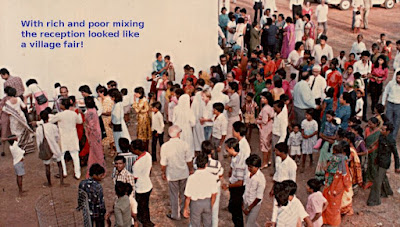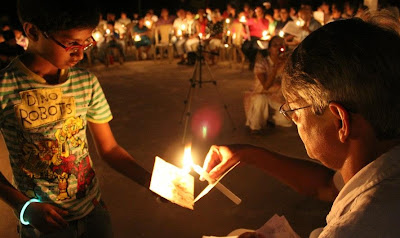Wedding On A Budget: a 250 guest wedding for less than £100
Muriel and Mario - M&M - two serious activists who lived in my village, Saligao, in Goa (India) dramatically inspired and informed my views on wedding budgets.
 |
| They rode their own 50 cc 'limousine' to church... |
Understanding their values-based spending also gave me true insight, very early on, into a conscious relationship with money, the focus of many of my blogs.
Although I was only a child, 9 years old or so, I remember it vividly both from inside the small chapel and later, at the reception. The weddings I had attended until then had the usual run of the mill offerings; unlimited soft drinks, a huge food buffet, a wedding hall that could host a football game, a live band, hundreds of people and in Goa, the wedding couple arriving at least 2 hours late. Yawn.
This one was unique.
Years later, talking to the couple, as an adult, I learned other details about this unusual wedding and want to share how M&M planned it - keeping in mind their values, their work as social activists and the community that was important to them.
Dress local
Their attire was simple. The bride wore a plain, cotton saree, with ethnic, hand dyed, bandhani - tie-and-dye - motifs in red and green: traditional wedding colours in Goa. The groom wore a cream, traditional Indian kurta-churidar, made from khadi, a local fabric hand woven from hand spun, cotton thread.
 |
| Begining with this walk down the aisle, 'they have walked their talk,' as a team couple, for the last 30 years and will continue for the next 30... |
At the time, the usual custom in Goa was to wear Western outfits - a weighty, lacy, flowing, gown-styled white wedding dress for the woman; for the man, a dark suit was standard. This western influence was due to the Portuguese colonial presence in Goa, and of course, such costuming was wholly inappropriate for the weather. A hot and humid summer wedding, left the bride 'glowing' profusely, while the long sleeved groom sweated silently under his often double-breasted jacket and trousers, always tailored from heavy polyester or nylon blended fabrics.
 |
| Exchanging vows |
M&M's outfits were different. They dressed local.
There was no fancy service or orchestrated Mass. They invited everyone they knew: family and all friends, as well as the people from an entire hutment colony, with whom they worked. Most of the hutment dwellers had never witnessed a Catholic wedding before. There was no scarcity mindset with the guest list - like I said, they invited everyone they knew.
Inclusive and Warm
The small chapel was packed and heaving with people from all sections of society. I really enjoyed seeing how inclusive M&M were; and the warmth and diversity in the room. As is conventionally done, M&M did not sit directly in front of the altar. Instead, to emphasise that this was a community celebration, they sat on the side, close to their family.
 |
| The couple sat with their families, instead of apart and in the middle of the chapel |
Many of the hutment dwellers entered the chapel late. They were embarrassed to enter a church full of 'well-dressed' invitees and so, stood at the doors and windows, peering inside, curiously. Seeing this, the bridal couple did the unthinkable: they stopped the service!
The groom went to the door and ushered the crowd in, right up to the front. There was no place for them to sit, so most of them crowded near the communion rails, just in front of the altar. Others sat in the pews that some of the couple's friends thoughtfully vacated for the new guests.
 |
| Hutment friends, poured in from the side door and crowded out the guests who had come in earlier |
During the ceremony, the hutment dwellers walked up to the couple and tried to give gifts. The bridal couple seemed to handle all of this with ease; I remember feeling very amused, never having witnessed these sorts of interruptions in a church or chapel (be solemn!) ever before.
The congregation watched this crazy move in hushed amazement, some in utter disbelief.
 |
| More hutment friends at the side door |
 |
| The couple insisted that a Muslim woman friend from the hutment colony, sign as one of their witnesses |
Chai and biscuits for all.
 |
| With rich and poor mixing, the reception looked like a 'village fair!' |
The older folk from among the poor, squatted on the bare, stony ground, and their children ran around and played merrily. It was so simple.
 |
| Family and friends help serve 'chai' and Coconut Crunchee biscuits |
 |
| The tea-stall owner, kept the urn topped up with piping hot 'chai!' |
A 250 guest wedding for less than £100!
The wedding budget and spend for the entire event was as ordinary and simple as the ceremony: the couple spent not a paisa (like a penny but in Indian Rupees) more than Rs. 1,000/- on everything. Inflation and currency adjusted, this
would be £97.38 in today's money (or less than Rs. 8,000/-). This is still unbelievable for the cost of a wedding!
So, lets breakdown this wedding budget. While Muriel's saree cost Rs. 125/-, Mario's full outfit was considerably less at Rs. 80/-.
 |
| Traditional Goan 'mangalsutra,' made from family silver |
The mangala sutra - a traditional necklace worn by Indian women, after marriage, the 2 wedding rings and the bride's 4 bangles were intentionally made of silver. Gold was symbolically shunned. And because the white metal came from silverware that the family already owned, only making costs were paid for.
 |
| Exchanging silver rings |
Invitations were basic, they were typed out in red on yellow paper and posted.
Likewise, instead of the fancy wedding limousine, the couple pillion-rode themselves to church on their trusty little, 50 cc, scooter.
Shop local, helps wedding budget
The tea for the reception was ordered from a roadside tea-stall opposite the chapel and served by the couple's friends in the ordinary, small, ribbed glass tumblers that tea is traditionally served in, at all roadside tea shops. 'Coconut Crunchee' biscuits - a slightly tastier variety, for the special occasion - were bought at wholesale rates in bulk packs, so that everyone could have as many as they wanted.
M&M were thrilled to see the hutment children eat as much as they could and stuff their pockets to take back to their siblings and friends left at home!
Their major expense was photography. The couple decided that photo documentation was important, so they 'splurged' on the 4 rolls of film that a priest friend covered the event with. The film, development and printing cost nearly 50% of the whole budget!
And oh yes, the couple had a bouquet of fresh flowers. No artificial, plastic flowers for them. But as tradition would have it, the flowers did not come at the beginning of the ceremony.
 |
| The author of the blog, 9 year old, Cleona Lira with her mother, leads the "3 little angels" to wish the couple. Their spontaneous gift: fresh flowers from the chapel compound |
It was the perfect, heart-warming way to end a wedding ceremony, they confessed 30 years later.
 |
| Poor hutment friends, insisted on giving presents, even though they were told not to. The couple were in tears. 3 decades later, they still gratefully use the gifts. |
Enlist the help of family and friends
 |
| Some of Muriel's wider family |
 |
| A few friends |
 |
| Some hutment friends |
My own wedding budget
In turn, when I got married, in 2012, it was a simple affair and a simple wedding budget. All in, I spent less than £1,200 on the actual event. It was a beach wedding in Goa - a casual affair just like I dreamed.
My family and friends helped me execute the details. Family members helped to make a little sand shaped heart, from the abundant beach sand, in which we stood to make our vows in the evening sunset. We didn't pay for the venue - the restaurant just gave a section of it to us after my aunt managed to sweet talk the owner into this. Although I was happy to pay more for the food, she kicked me under the table when negotiating, so I decided to keep out of it.
I bought a second-hand dress on Ebay by Forever Unique, a luxury fashion brand. Post wedding, I sold it for the same price I bought it for (all of £50).
I invited 35 guests which is unusual for an Indian wedding. My mother was instructed not to invite anybody - she found this incredibly hard and yet, for the most part, obeyed instructions. And a friend of mine who has a successful alcohol business provided the cocktails; I later found out when I tried to pay for it, this was a gift!
I had one bouquet of flowers which were bought from the local flower market by my sister. And the delicious cake was baked with love by Alisha, my cousin, friend and cake goddess. It didn't break the bank. Not one bit.
And from the great feedback from the guests, they all had fun. Fun was important to me.
Extravagant weddings - not a fan
Often, I get asked, "Ah, you are Indian - so did you have a 3- day wedding?"
Well, not all of us do, although we love celebrating for sure. Some weddings are grander than others including a £15 million wedding by Sanjay Hinduja, complete with Jennifer Lopez performing and no expense spared. Wedding trousseaus, traditions, spending to keep up with the Joneses or well, D'Souza's in this case and inviting people (because they invited us or what would they say?) does not feel authentic to me.
And yet, everyone is entitled to spend and celebrate as they wish, in line with their own values.
My only wish is for people to really be conscious and spend with financial integrity; choosing to spend based on what is important to them, not what society dictates or to keep up with 'looking good'.
When I read about extravagant weddings, like the Hinduja £15 million wedding, my thoughts go to how that money could have been better utilised. A quick search on Google reveals that the average English wedding costs about £24,000. I would rather save that towards something more useful.
I worked with a colleague who was heavily in debt and yet took a large personal loan to give his girlfriend the marriage of her dreams – I thought it was most unromantic to start a marriage in debt.
Thank you, M&M
I chose a modest wedding budget when I dreamed up my own wedding and the joy in organising this with some creativity and the help of family and community was worth it.
Warmth and fun weren't compromised; money was spent with care.
Thank you to Muriel and Mario for this early inspiration to me, on this journey of being conscious with money. And for hopefully inspiring many, many others with the beautiful story of your wedding.
****************************
----------------------------------------------------------
About the author
is a professional investment guide
and financial planning consultant in the UK.
wholeheartedness into my work. I really enjoy what I do; I am grateful
that this is the way I get to make a living. Money can be a heavy topic
and I aim to make the financial planning process as engaging and easy
as possible.
Association-UKSIF.org. You can also find me on the FCA register if you
search for me by name.”
More about Cleona and her services:
https://www.cleonalira.co.uk/about-1
(Services available only in the UK...unfortunately! 😞)




























